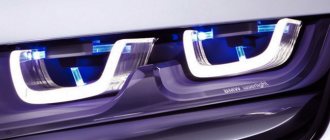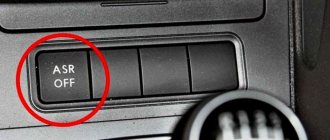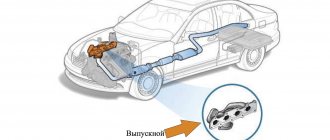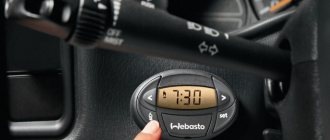With the advent of self-propelled vehicles, the risk of accidents on the roads has increased. Every new car, even a budget model, is tailored to the growing demands of modern drivers. So, the car can get a more powerful or economical power unit, improved suspension, a different body and a variety of electronics. Since cars on the roads are a potential source of danger, each manufacturer equips its products with all kinds of systems to ensure safety.
This list includes both active and passive safety systems. An example of this is airbags (their structure and operating principle are described in more detail in another article ). However, some equipment can be classified as both a safety and comfort system. This category includes the head light of the car. We no longer imagine a single vehicle without external lighting. This system allows you to continue driving even in the dark, since the road is visible thanks to a directed light beam in front of the car.
Modern cars can use different light bulbs to improve road illumination (standard lamps do a poor job of this task, especially at dusk). Their varieties and work are described in detail here . Despite the fact that the new headlight elements demonstrate better lighting characteristics, they are still far from ideal. For this reason, leading car manufacturers are developing different systems that allow them to achieve the optimal parameter between safe and efficient light.
Such developments include adaptive light. In classic vehicles, the driver can switch the low or high beam, as well as turn on the dimensions (read about what function they perform separately ). But such switching in many cases does not provide good visibility of the road. For example, city mode does not allow the use of high beams, and in low beams the road is often difficult to see. On the other hand, switching to low beam often makes the side of the road invisible, which is why a pedestrian may be too close to the car, and the driver may not notice him.
A practical solution is to make optics that provide the perfect balance between illumination of the roadside and safety for oncoming traffic. Let's look at the device, types and operating features of adaptive optics.
What are adaptive headlights and adaptive lighting?
Adaptive optics is a system that changes the direction of the light beam depending on the road situation. Each manufacturer implements this idea in its own way. Depending on the modification of the device, the headlight independently changes the position of the light bulb relative to the reflector, turns on/off some LED elements, or changes the brightness of the illumination of a certain section of the road.
There are several modifications of such systems that work differently and are adapted for different types of optics (matrix, LED, laser or LED type). This device operates automatically and does not require manual configuration. For efficient operation, the system is synchronized with other transport systems. The brightness and position of the light elements are controlled by a separate electronic unit.
Here are just a few situations in which standard light does not do its job:
- Driving on the highway outside the city allows the driver to use high beams. An important condition for this is the absence of oncoming traffic. However, some drivers do not always notice that they are driving in high-light mode and blind oncoming traffic participants (or in the mirrors of drivers of cars in front). To increase safety in such situations, the adaptive headlights automatically switch the lights.
- When the car enters a sharp turn, the classic headlights shine exclusively forward. For this reason, the driver sees the road around the bend worse. The automatic light reacts to the direction in which the steering wheel is turned and, accordingly, directs the light beam to where the road leads.
- A similar situation occurs when a car goes up a hill. In this case, the light shines upward and does not illuminate the road. And if another car is driving towards you, the harsh light will definitely blind the driver. The same effect is observed when overcoming passes. An additional drive in the headlights allows you to change the angle of the reflector or the light element itself so that the road is always as visible as possible. In this case, the system uses a special sensor that detects the inclination of the road surface and adjusts the operation of the optics accordingly.
- In city mode at night, when driving through an unlit intersection, the driver sees only other vehicles. If you need to turn, it is extremely difficult to notice pedestrians or cyclists on the roadway. In such a situation, the automation activates an additional spotlight, which illuminates the turning area of the car.
The peculiarity of different modifications is that in order to activate certain functions, the speed of the machine must correspond to a certain value. In some situations, this helps drivers adhere to speed limits allowed within populated areas.
Origin story
For the first time, headlight technology capable of changing the direction of the light beam was used on the iconic Citroen DS model, starting in 1968. The car received a modest but very original system that turned the headlight reflectors in the direction of the steering wheel. This idea was brought into reality by engineers of the French company Cibie (founded in 1909). Today this brand is part of the Valeo company.
Although at that time the device was far from ideal due to the tight physical connection between the headlight drive and the steering wheel, that development formed the basis for all subsequent systems. For many years, motorized headlights were considered more of a toy than a useful piece of equipment. All companies that tried to use this idea faced one single problem that did not allow them to improve the system. Due to the tight connection between the headlights and the steering, the light still adapted to turns late.
After the French company founded by Leon Sibier became part of Valeo, this technology received a “second wind”. The system was improved so quickly that not a single manufacturer was able to get ahead of the release of new things. Thanks to the introduction of this mechanism into the external lighting system of vehicles, driving a car at night has become safer.
The first truly effective system was AFS. The new product appeared on the market under the Valeo brand in 2000. The first modification also had a dynamic drive that responded to steering wheel turns. Only in this case the systems did not have a rigid mechanical connection. The degree by which the headlight turned depended on the speed of the car. The first model to be equipped with such equipment was the Porsche Cayenne. This type of equipment was called the FBL system. If the car was moving at high speed, the headlights could be turned in the direction of the turn by a maximum of 45 degrees.
Porsche Cayenne
A little later the system received a new update. The new product is called Corner. This is an additional static element that illuminated the turning area where the car was about to go. Illumination of part of the intersection was provided by turning on the corresponding fog lamp, directed slightly away from the central light beam. This element could be activated when turning the steering wheel, but more often after turning on the turn signal. An analogue of this system is often found in some models. An example of this is the BMW X3 (an external light element is turned on, often a fog light in the bumper) or a Citroen C5 (an additional spotlight mounted in the headlight is turned on).
Citroen C5
The next evolution of the system concerned the speed limit. The DBL modification determined the speed of the car and adjusted the brightness of the elements (the faster the car moves, the farther the headlight shines). Moreover, when a car enters a long turn at speed, the inner part of the arc is illuminated so as not to blind oncoming drivers, and the beam of the outer arc hits further and is shifted towards the turn.
Since 2004, the system has evolved even more. A modification of Full AFS has appeared. This is a fully automatic option, which no longer worked based on the driver’s actions, but on the readings of various sensors. For example, on a straight section of the road the driver could maneuver around a small obstacle (a hole or an animal), and turning on the turn lights is not required.
Such a system has already been found as a factory option in the Audi Q7 (2009). It consisted of different LED modules that light up in accordance with signals from the control unit. Headlights of this type are capable of rotating in a vertical and horizontal plane. But even this modification was not ideal. For example, it made night driving around the city safer, but when the car was moving along a winding road at high speed, the electronics could not independently switch the high/low beam - the driver had to do this independently so as not to dazzle other road users.
Audi Q7 2009
The next generation of adaptive optics is called GFHB. The essence of the system is as follows. A car can constantly drive at night with its high beams on. When oncoming traffic appears on the road, the electronics react to the light from it and turn off those elements that illuminate that area of the road (or move the LEDs to form a shadow). Thanks to this development, while driving at high speed on the highway, the driver could use high beams all the time, but without harm to other road users. For the first time, this equipment began to be included in the design of some xenon headlights in 2010.
With the advent of matrix optics, the adaptive light system received another update. Firstly, the use of LED blocks made it possible to make the exterior lighting of a car even brighter, and the working life of the optics increased significantly. The efficiency of illumination of turns and long bends has increased, and when other cars appear in front of the vehicle, the light tunnel has become clearer. A special feature of this modification is the reflective screen moving inside the headlight. This element provided a smoother transition between modes. This technology can be found in the Ford S-Max.
The next generation is the so-called sail beam technology, which was used in xenon optics. This modification eliminated the disadvantage of this type of headlights. In such optics, the position of the lamp changed, but after darkening a section of the road, the mechanism did not allow the element to quickly return to its original position. Sailing light eliminated this drawback due to the fact that two independent light modules appeared in the headlight design. They are always directed towards the horizon line. The low beam works on a constant basis, and the horizontal ones shine into the distance. When an oncoming car appears, the electronics pushes these modules apart so that the beam of light is cut into two parts, between which a shadow is formed. As the cars approached, the position of these lamps changed.
A moving screen is also used to operate dynamic shadows. Its position depends on the approach of an oncoming vehicle. However, in this case there was a significant drawback. The screen was only able to darken one section of the road. Therefore, if two cars appear in the oncoming lane, the screen simultaneously blocked the light beam for both vehicles. The further generation of the system was called Matrix Beam. It is installed in some Audi models.
This modification has several LED modules, each of which is responsible for illuminating a specific area of the route. The system turns off the block that, according to sensor data, will blind the driver of an oncoming car. In this design, the electronics are capable of turning off and turning on different units, adjusting to the number of cars on the road. The number of modules is, of course, limited. Their number depends on the size of the headlight, so the system is not able to control the dimming of each car if the oncoming traffic is thick.
The next generation eliminates this effect to some extent. The development is called “Pixel Light”. In this case, the LEDs are installed motionless. More precisely, the light beam is already generated by a matrix LCD display. When a car appears in the oncoming traffic, a “dead pixel” (a black square, which forms a darkening on the road) appears in the beam. Unlike the previous modification, this development is capable of simultaneously tracking and shading several cars at once.
The latest adaptive optics technology today is laser light. Such a headlight can hit a car in front at a distance of about 500 meters. This is achieved thanks to a concentrated beam of high brightness. On the road, only those with farsightedness are able to recognize objects at such a distance. But such a powerful beam will be useful when the car is moving along a straight section of road at high speed, for example, along a highway. Given the high speed of transport, the driver must have enough time to react in time if the situation on the road changes.
What are the clinical criteria for antiphospholipid syndrome?
Clinical criteria for antiphospholipid syndrome:
- Vascular thrombosis. The patient must have one or more episodes of arterial, venous or capillary thrombosis of vessels of any location (with the exception of saphenous vein thrombosis, which is not a diagnostic criterion for APS). In this case, thrombosis must be objectively confirmed using a Doppler study (with the exception of superficial thrombosis). Also, when conducting histopathological confirmation of thrombosis, there should be no significant signs of inflammation of the vascular endothelium.
- Pregnancy pathologies:
- 1 or more cases of intrauterine death of a normally developing fetus after 10 weeks of gestation (in this case, documented ultrasound confirmation is required that the fetus was developing normally).
- 1 or more cases of premature birth (normal fetus before the 34th week of gestation) against the background of severe gestosis of pregnancy (preeclampsia, eclampsia, severe placental insufficiency).
- 3 or more spontaneous abortions before the 10th week of gestation (provided there are no pathologies of fetal development, anatomical defects of the uterus, hormonal pathologies and disorders, chromosomal disorders in the child’s father or mother).
What are the diagnostic laboratory criteria?
Laboratory criteria to identify APS include:
- Detection of antibodies to cardiolipin (aCL) IgG and/or IgM isotypes in blood serum. In this case, immunoglobulin titers should be medium or high. Elevated titers should be detected at least 2 times in the last two months (the enzyme-linked immunosorbent assay (ELISA) method is used to detect immunoglobulins).
- Determination of lupus anticoagulant (lupus anticoagulant) in the patient’s plasma. In this case, lupus antigen must be determined in 2 or more tests, and the interval between tests must be at least 12 weeks.
In addition to the screening study (APTT (activated partial thromboplastin time), PT (prothrombin time), kaolin clotting time), the following should be performed:
- confirmatory coagulation tests;
- determination of TV (thrombin time) to exclude heparin effects in the test sample.
- The presence of antibodies to beta-2-glycoprotein (B2-GPI) IgG or IgM isotypes in the blood serum. In this case, antibody titers must be medium or high, and must be determined at least 2 times with an interval between tests of more than 12 weeks. To determine antibodies to beta-2-glycoprotein, the ELISA method is used.
Purpose and operating modes
As can be seen from the history of the system, it was developed and improved for one purpose. While driving in the dark at any speed, the driver must constantly monitor the situation on the road: are there any pedestrians on the roadway, is someone going to cross the road in the wrong place, is there a risk of hitting an obstacle (for example, a branch or a hole in the asphalt) ). To control all these situations, quality light is extremely important. The problem is that in the case of stationary optics it is not always possible to provide it without harm to oncoming drivers - the high beam (it is always brighter than the low beam) will inevitably blind them.
To assist the driver, automakers offer various modifications of adaptive optics. It all depends on the financial capabilities of the car buyer. These systems differ not only in the blocks of light elements, but also in the operating principle of each installation. Depending on the type of device, the following road lighting modes may be available to the motorist:
- City . This mode operates at low speeds (hence the name - city). The headlights shine widely while the car travels at a maximum of 55 kilometers per hour.
- Country road . The electronics move the light elements so that the right side of the road is illuminated more strongly, while the left side is illuminated in standard mode. This asymmetry allows pedestrians or objects on the side of the road to be recognized earlier. Such a light beam is necessary, since in this mode the car drives faster (the function works at 55-100 km/h), and the driver must notice foreign objects in the car’s path earlier. At the same time, the oncoming driver is not blinded.
- Motorway . Since a car on the highway moves at a speed of about 100 kilometers per hour, the operating range of the light should be greater. This uses the same asymmetrical beam as in the previous mode, so that oncoming drivers are not dazzled.
- Far/near . These are standard modes that are present in all cars. The only difference is that in adaptive optics they switch automatically (the driver does not control this process).
- Turning light . Depending on which direction the car is turning, the lens moves so that the driver can recognize the nature of the turn and foreign objects in the car’s path.
- Poor road conditions . Fog and heavy rain combined with darkness pose the greatest danger to moving vehicles. Depending on the type of system and light elements, the electronics determine how bright the light should be.
1) Turning light;
2) Backlighting in bad road conditions (for example, fog); 3) City mode (red), highway driving (orange); 4) Highway mode The key task of adaptive light is to minimize the risk of an accident as a result of hitting a pedestrian or an obstacle due to the fact that the driver was unable to recognize the danger in advance in the dark.
Benefits of participating in American programs
Staying abroad for a long time is always a risky undertaking. But we must pay tribute to the organizers, they are trying to eliminate all problems that may arise in the process. Therefore, participants can expect mainly clear benefits, where they will be able to derive maximum benefits for themselves:
- Schoolchildren will be able to significantly improve their English skills by entering the appropriate language environment.
- Participants will be able to broaden their horizons, which will have a positive impact on their choice of life path in the future.
- An opportunity to make friends and useful contacts for many years.
- The organizers monitor the safety of participants. All families accepting schoolchildren are carefully checked, and preference is given to those well off with children.
Adaptive head lighting options
The most common types of adaptive optics are:
- AFS. This abbreviation literally translates from English as adaptive front light system. Various companies produce their products under this name. Initially, the system was developed for Volkswagen brand models. Such headlights are capable of changing the direction of the light beam. This function is triggered based on algorithms that are activated when the steering wheel is turned a certain degree. The peculiarity of this modification is that it is compatible only with bi-xenon optics. The headlight control unit is guided by indicators from different sensors, so that when the driver goes around some obstacle on the road, the electronics do not switch the headlights to the cornering light mode, and the bulbs continue to shine forward.
- AFL. This abbreviation literally translates as adaptive road lighting system. This system is found on some Opel models. This modification differs from the previous one in that it not only changes the direction of the reflectors, but also provides static adjustment of the light beam. This function is achieved by installing additional light bulbs. They turn on when the turn signals are activated. Electronics determines at what speed the car is moving. If this parameter is above 70 km/h, then the system only changes the direction of the headlights themselves depending on the turn of the steering wheel. But as soon as the car’s speed drops to the permissible speed in the city, the turns are additionally illuminated by a corresponding fog light or an additional lamp located in the headlight housing.
Specialists from the VAG concern are actively developing an adaptive road lighting system (read about which companies are part of this concern in another article ). Despite the fact that very effective systems already exist today, there are prerequisites that the device will evolve, and some modifications of the systems may appear in budget cars.
Headlights of the future
Auto designers are developing several innovations in headlight technology that should appear on production models in the next few years. Adaptive brake lights allow you to see more than just the vehicle applying the brakes. You'll also learn how effectively the driver applies the brakes, giving you a good idea of the problems on the road ahead or how long it will take you to slow down.
Dedicated fiber optic headlights have the potential to literally revolutionize automatic lighting, creating a wider range of lighting options and optimal light configurations. A single source system uses a single lighting element located somewhere inside the vehicle. Fiber optic threads carry light where it is needed.
Instead of two headlights, the car may have a wide light-emitting pattern at the front. Fiber optics can be driven by special small motors that can provide even more flexible adaptive lighting. The current disadvantage is that fiber optics lose a lot of light intensity as they are carried, so a very bright source is needed to implement such a system.
Types of adaptive systems
The most effective system today is the one that performs all the functions described above. But for those who cannot afford such a system, automakers also offer budget options.
This list includes two types of such devices:
- Dynamic type. In this case, the headlights are equipped with a rotating mechanism. When the driver turns the steering wheel, the electronics move the position of the lamp in the same direction as the turning wheels (similar to the principle of a motorcycle headlight). Switching modes in such systems can be standard - from near to distant and back. The peculiarity of this modification is that the lamps do not rotate at the same angle. Thus, a headlight illuminating the inside of a turn will always move in the horizontal plane at a larger angle compared to the outside. The reason is that in budget systems the intensity of the beam does not change, and the driver must clearly see not only the inside of the turn, but also the lane along which he is moving, with part of the side of the road. The device operates on the basis of a servo drive, which receives appropriate signals from the control unit.
- Static type. This is a more budget option, since it does not have headlight drive. Adaptation is achieved by including an additional light element, for example, a fog light or a separate lens installed in the headlight itself. True, this adjustment is only available in city mode (low beam headlights are on and the car is moving at speeds of up to 55 kilometers/hour). Typically, an additional light turns on when the driver engages a turn or turns the steering wheel to a certain angle.
Premium systems include a modification that not only sets the direction of the light beam, but also, depending on the road situation, can change the brightness of the light and the tilt of the headlights if a pass is overcome. In budget car models, such a system is never installed, since it works using complex electronics and a large number of sensors. And in the case of premium adaptive light, it receives information from the front video camera, processes this signal and activates the appropriate mode in a split second.
Let's look at the device and on what principle the two common automatic light systems will work.
Advantages
- reduction of accidents. Adaptive headlights do an excellent job of illuminating the roadway and surrounding areas. Thanks to this, the driver is better informed about everything that is happening on the highway, which allows him to react in time and take the necessary actions to prevent an accident.
- more comfortable control for the driver. Automatic light eliminates the need for the driver to switch headlight modes. The optics installed in the car independently adapt to the terrain and lighting conditions.
- assistance to the driver on dangerous road sections. Adaptive headlights perform better than standard optics on dangerous sections of the road (sharp turns, ascents and descents), as well as in conditions of minimal visibility (fog).
- presence of an intelligent control system. Adaptive light in modern business sedans and other cars adapts to a specific driving situation without driver intervention. The system makes the right decision with minimal probability of error based on data received from a large number of sensors. The driver only needs to select the operating mode of the smart headlights.
Design and principle of operation of AFS
As already mentioned, this system changes the direction of light. This is dynamic adjustment. In the technical literature for Volkswagen models, you may also find the abbreviation LWR (headlight range adjustment). The system works with xenon light elements. The design of such a system includes an individual control unit, which is connected to several sensors. The list of sensors whose signals are recorded to determine the position of the lenses includes:
- Vehicle speed;
- Steering wheel position (installed in the area of the steering rack, which can be read about separately );
- Stability control systems, ESP (read about how it works here );
- Windshield wipers operate.
Standard adaptive optics works according to the following principle. The electronic control unit records signals from all sensors connected to the device, as well as from a video camera (its availability depends on the system modification). These signals allow the electronics to independently determine which mode to activate.
Next, the headlight drive system is activated, which, in accordance with the algorithms of the control unit, drives the servo drive and moves the lenses in the appropriate direction. Thanks to this, the light beam is corrected depending on the road situation. To activate the system, you must move the switch to the Auto position.
Comparison of AFS flow sensors with analogues
| Parameter | AFS | P1 | P2 | P3 | P4 | P8 |
| Application | Compatible liquids and gases | Compatible Fluids | Compatible liquids and gases | Compatible Fluids | Compatible Fluids | Compatible Fluids |
| Flow range | 2…76 l/min for liquid 28…2124 m3/hour for gases | 0.38…5.67 l/min | 0.23…4.6 l/min for liquid 0.7…0.15 m3/hour for gases | 0.25…7.57 l/min | 0.38…5.68 l/min | 0.95…7.57 l/min |
| Wetted Materials | Body – brass or stainless steel. steel grade 316 SS, choice of piston - polysulfone, brass or stainless steel. steel 316 SS, spring – stainless steel. 316 SS, O-ring - fluoroelastomer | Body – brass, piston – polysulfone, spring – stainless steel. 316 SS steel, fluoroelastomer O-ring | Body - polyphenylene ether (PPE) and polystyrene (PS), piston - PPE and PS and epoxy resin, spring and locking pin - stainless steel. 316 SS steel | Round body made of polypropylene, sensor piston made of PPS composite, metallic. stainless steel spring 316 SS steel, fluorocarbon O-ring | Body and piston made of polyphenylene sulfide (PPS) grade R4, spring made of stainless steel. 316 SS steel, fluoroelastomer O-ring (fluoride rubber) | Body made of brass, piston made of polyphenylene sulfide (PPS) and epoxy resin, spring made of stainless steel. steel grade 316 SS, seal. ring made of fluoroplastic (fluorocarbon) |
| Working temperature | -29…+149°C | -29…+107°C | -18…+100°C | -18…+100°C | +17…+107°C | -28…+135°C |
| Operating pressure | up to 68 bar | up to 68.9 bar | up to 10 bar | up to 9 bar | up to 17 bar | up to 104 bar |
| Accuracy | ±10% | ±10% | ±10% | ±20% | ±15% | ±20% |
| Switching capacity of contacts and their type | SPST 0.17A/120V AC 0.08A/240V AC 0.13A/120V DC 0.06A/240V DC | SPDT 0.17A/120V AC 0.08A/240V AC 0.13A/120V DC 0.06A/240V DC | SPST 0.17A/120V AC 0.08A/240V AC 0.13A/120V DC 0.06A/240V DC | SPST 0.08A/120V AC | SPST or SPDT 0.17A/120V AC 0.08A/240V AC 0.13A/120V DC 0.06A/240V DC | SPDT 0.17A/120V AC 0.08A/240V AC 0.13A/120V DC 0.06A/240V DC |
| Required filtration level | 50 microns | 50 microns | 50 microns | 100 microns | 50 microns | 100 microns |
Unlike models of the P1-8 series, AFS piston relays are designed for a wider temperature range and are capable of operating with higher flow rates.
Design and principle of operation of the AFL system
This modification, as mentioned earlier, not only changes the direction of the light, but also illuminates turns at low speeds with stationary lamps. This system is used on Opel cars. The design of these modifications is not fundamentally different. In this case, the headlight design is equipped with additional light bulbs.
When the car moves at high speed, the electronics record the degree of rotation of the steering wheel and move the headlights to the appropriate direction. If the driver needs to go around an obstacle, the light will shine directly, since the directional stability sensor has detected a change in the position of the body, and the corresponding algorithm has worked in the control unit, which prevents the electronics from moving the headlights.
At low speeds, turning the steering wheel simply turns on the additional side lighting. Another feature of AFL optics is its compatibility with special optics that shine equally brightly in both long and near modes. In these cases, the beam tilt changes.
Here are a few more features of this optics:
- Able to change the angle of the light beam up to 15 degrees, which improves visibility when ascending or descending a mountain;
- When cornering, road visibility increases by 90 percent;
- Due to the side lighting, it is easier for the driver to pass through intersections and notice pedestrians in time (some car models use a light alarm that winks at pedestrians, warning them that a car is approaching);
- When changing lanes, the system does not switch modes;
- Independently controls the transition from near to far illumination mode and vice versa.
Despite these advantages, adaptive optics is still inaccessible to most motorists, since it is often included in the premium equipment of expensive cars. In addition to the high cost, repairing failed mechanisms or troubleshooting electronics will be expensive for the owner of such optics.
Modern lighting systems at the exhibition
At the annual international exhibition "Electro"
, which will be held this summer at the Expocentre Fairgrounds, you will have the opportunity to get acquainted with modern lighting systems.
In the industrial lighting section you will find
:
- office lighting systems;
- design of such systems;
- street, outdoor, emergency, road and emergency lighting;
- light sources (traditional, semiconductor, LED and others);
- technologies and devices for the manufacture of lighting products;
- recycling of damaged lamps and much more.
"Electro"
is a large-scale exhibition in which manufacturers from around the world annually take part: Germany, India, China, the Czech Republic, Spain, etc.
At this exhibition you can not only learn about modern trends in the field of lighting technology, but also conclude profitable contracts with global manufacturers. This will only have a positive impact on your company.
All equipment presented at this event is certified, of high quality and efficiency.
If your company produces similar equipment and has the latest innovative technological developments, then you can take a direct part in "Electro"
. To do this, you just need to go through a quick registration procedure.
At the exhibition you can learn more about lighting systems: adaptive, street, artificial, modular, LED.
Track lighting systemLED lighting systemsDesign of industrial facilities
What does AFS OFF mean?
When the driver sees the message AFS OFF on the instrument panel, this means that automatic headlight adjustment is not performed. The driver must independently switch the low/high beam. The electronics are activated using the corresponding button on the steering column switch or on the center panel.
It happens that the system deactivates on its own. In some cases, this occurs due to software failures. This problem can be resolved by pressing the AFS button again. If this does not help, you need to turn off the ignition and turn it on again so that the car’s on-board system performs self-diagnosis.
If there is some kind of breakdown in the adaptive light system, it will not turn on. Malfunctions due to which the electronics will not work include:
- Failure of one of the sensors associated with the system;
- Control unit errors;
- Malfunctions in the wiring (lost contact or line break);
- Failure of the control unit.
To find out what exactly the problem is, you need to take the car for computer diagnostics (read about how this procedure is performed here ).
AFS File Summary
According to our records, there are one file type(s) associated with the AFS extension, the most popular of which is formatted as STAAD.foundation Project File. The most common associated application is Bentley Systems STAAD Foundation Advanced, released by Bentley Systems. Additionally, one different program allows you to view these files. Most AFS files are classified as CAD Files.
AFS files can be viewed using the Windows operating system. They are typically found on desktop computers (and some mobile devices) and allow you to view and sometimes edit these files. AFS files have a Low popularity rating. This means they are not common on most devices.
What are similar systems called by different manufacturers?
Each automaker that equips its cars with adaptive lighting calls the development differently. Despite the fact that this system is known all over the world, three companies are developing and improving this technology:
- Opel The company calls its system AFL (additional edge lighting);
- Mazda. The brand calls its development AFLS;
- Volkswagen. This automaker was the first to introduce Leon Sibier's idea into production cars, and called the system AFS.
Although these systems are found in their classic form in models of these brands, some automakers are trying to improve the safety and comfort of driving at night by slightly modernizing the optics of their models. However, such modifications cannot be called adaptive headlights.
What cars is it used in?
Smart headlights are installed in cars of various brands and manufacturers. Previously, these systems were the prerogative of only flagship models like the Mercedes S-Class, BMW 7 Series, Audi A8, etc. Now adaptive lighting can be found in cars such as VW Passat and Tiguan, Skoda Superb, Hyundai Tucson, Kia Optima, etc.
Increasingly, smart optics are appearing in family sedans, crossovers and SUVs in the mid-price segment.
What is the AFLS system?
As we noted a little earlier, the AFLS system is a development of Mazda. At its core, it is not much different from previous developments. The only difference is in the design features of the headlights and lighting elements, as well as a slight correction of operating modes. Thus, the manufacturer set the maximum angle of inclination relative to the center at 7 degrees. According to the engineers of the Japanese company, this parameter is as safe as possible for oncoming traffic.
Other adaptive optics features from Mazda include:
- Change the horizontal position of the headlights within 15 degrees;
- The control unit determines the position of the car relative to the road and adjusts the vertical angle of the headlights. For example, when fully loaded, the rear of the car can squat strongly, while the front can rise. In the case of conventional headlights, even the low beam will blind oncoming traffic. This system neutralizes this effect;
- Turning lights at an intersection are provided so that the driver can promptly recognize foreign objects that could create an emergency situation.
So, adaptive light provides maximum comfort and safety during night driving. Additionally, we suggest looking at how one of the varieties of such systems works:
Škoda Octavia 2022 - that's who has the best standard light!
Optics adjustment method
There are nuances in managing the AFS system. If the sensor blinks, this means an error has occurred after changing the battery or due to oxidation of the contacts. To disable the sensor, you must perform the following steps:
- Disconnect the system.
- Turn off the engine.
- Start the car engine.
- Connect lighting.
- Turn off and start the engine again.
If AFS off is on, then you need to undergo diagnostics and maintenance.
Thanks to these optics, the driver feels confident and sees the road better. The system operates in many modes, determines the angle of inclination and its level, which provides better visibility and reduces accidents on the road surface.
Scanning lighting systems
Sensors that scan the space in front of the car (pattern recognition) are already used in production cars. An example of a pattern recognition system is a new type of sensor system that distinguishes objects in front of a car (developed by Audi). The new highly sensitive system is capable of forming a three-dimensional image of an obstacle in front of the vehicle (Fig. 14).
Rice. 14. Scanning lighting system
The technology is based on a source of modulated infrared radiation and a sensor (located behind the windshield at rear-view mirror level) made from new photosensitive semiconductor elements known as Photonic Mixer Devices (PMD). These devices are capable of processing signals returned from multiple points on an object simultaneously. Their structure is similar to conventional charge-coupled devices (the so-called CCD matrices) used in video and photo cameras. They take advantage of the differences in the time it takes for the rays to return from different objects in the scene to each of the sensing elements of the PMD array.
To calculate the volumetric image, the system compares the signal from each pixel of the matrix with a reference modulated signal supplied by the emitter circuit, while extraneous infrared light (for example, from the sun) is separated from its own signal.
The sensor's field of view horizontally is 32°, and vertically – 8°. The obstacle scanning frequency is 200 Hz, which allows you to quickly detect changes in the road situation.
Track lighting system
Today, a lot depends on lighting. The market for such devices is growing every day, offering us new innovative technologies every time.
The track lighting system is an original solution in the field of room electrification. This is the most optimal solution to create spot and general lighting.
Due to its undeniable features, this type of lighting is becoming very popular.
The track lighting system is economical, environmentally friendly, reliable and easy to install. Such lamps do not require additional monitoring. They are very durable.
The track system consists of: conductor, suspension, connecting elements and lighting fixture. They can be mounted not only on the ceiling, but also on the walls.
The entire structure can be located at any height and have different types of lamps that can be installed on a track system.
With this system you can illuminate your room in any direction and in hard-to-reach places.
The voltage of track systems is only 12 W. This makes this lighting safe and cost-effective. Plus, this is a very original design solution that can decorate the interior of your room.
Application
The most widely used are adaptive suspensions with a solenoid valve in active shock absorber struts. This set of mechanisms is installed on Opel, Volkswagen, Toyota, Mercedes-Benz cars. Chassis with magnetic rheological fluid is not very popular. It can be found on Audi, Cadillac and Chevrolet cars.
Manufacturers of active suspensions do not stand still. They combine all available options in order to improve their performance, as well as reduce size and weight. The main task is to achieve unique settings at each time for each individual wheel. This will raise comfort and safety another notch, as well as improve the vehicle's handling and stability.
Advantages and disadvantages
Analysis of the above allows us to highlight the following advantages of adaptive optics over conventional optics:
- good visibility directly in front of the car;
- lighting a turn before the car enters it;
- helps reduce accidents;
- do not blind the oncoming driver.
There are practically no disadvantages, except for the complexity of the design and the fairly high cost.
Do-it-yourself solution
Unfortunately, today only a small number of cars are equipped with adaptive lighting technology. It doesn't take much effort to equip your car with adaptive light sources. Of course, it will not be possible to achieve an original result, because it is created only with the help of modern technologies and an on-board computer. If the machine has standard power supplies, they can be equipped with a rotating mechanism, as well as adjust the tilt level.
It's important to think about the wiring first. Sensor elements must match the headlights
If an error occurs somewhere, the product model must be replaced. In practice, you will need two sensors that will be installed on the front wheels. To be able to control the adaptive, a special LCM module is used.
Let's get started with the installation
To install such a light yourself, you will need to open the front hood. To do this, it should be removed, but without touching the cables of the fog lights and the fluid supply to the washer. After this, the headlights themselves are disconnected. As a rule, they are mounted with 3 bolts. After this, it is necessary to conduct wiring from the new set of lights to the interior. Among the adapters there will be ground wires that need to be placed in the side members under the headlights.
For convenience, it is better to wrap all wires running into the cabin with electrical tape. Also, it is best to install the cable from the left headlight under the battery, and from the right one - behind the washer. After this, the headlights are assembled, and a unit for ignition and adaptive light is connected to them. After the connectors are connected, you can connect the battery to work. Next you need to gain access to the fuse box. The lamp wire is inserted into the black connector, which will supply energy to the lighting devices and start their operation.
Since sensors are connected to the vehicle's driving elements, they will be able to transmit a signal to the adaptive headlights. This system does not work on all machines, but a similar effect can be achieved on your own. Also, most modern functions cannot be implemented into the vehicle independently, since they require the operation of an on-board computer.
Today, AFLS adaptive xenon headlights have become a new trend. Drivers are attracted by their functionality and convenience, because they can make the trip much more comfortable. To acquire these devices, you can purchase headlights in specialized stores and install them yourself. This will give the lighting functionality as close as possible to the original.
To afford modern adaptive headlights that can change the angle of illumination, it is better to contact a specialized company that will select such devices for the car model
It’s possible to do this yourself, but it’s important to consider the compatibility of all elements and have sufficient skills
What's the result?
The Italian company has long had its interests in the automotive lighting market. Owned by her since 1998, the Carello brand is well known in Europe. The company's portfolio includes many advanced options for matrix technologies and laser high beams. Thus, it supplies matrix optics for Audi, as well as matrix optics with “laser” high beam for the new BMW i8.
Why such mystery? There is a suspicion that Magneti Marelli is violating Hella’s long-standing monopoly on the supply of optics for Mercedes-Benz, and the German company is trying not to emphasize this fact once again, without advertising its new technology partner. Moreover, Hella is unlikely to have run out of promising ideas.
The importance of quality road lighting
According to statistics, most road accidents occur at night. It can be difficult for a driver to estimate the distance to nearby obstacles; we simply may not see a pedestrian or other obstacles on the road, which leads to accidents with serious consequences
That is why great attention is paid to the quality of road lighting
The first headlights on cars were made with the simplest technology, often used ordinary incandescent lamps and did not always illuminate the road surface well. It's not surprising that automakers are constantly trying to come up with new ways to make head optics. They use LED, halogen and xenon headlights, which slightly improves the quality of road lighting at night.
The technology of adaptive headlights has become popular, which received a special motor suspension and a correction system that allows you to correctly illuminate the roadway, as if looking around a corner, providing improved visibility of the road when passing high-speed turns. Advanced adaptive headlight systems have received special devices that allow them to detect oncoming cars; they divert the flow of lighting to the side, preventing dazzling drivers of oncoming cars. The use of such adaptive headlights can significantly improve the quality of road lighting and increase the safety of driving at night.











